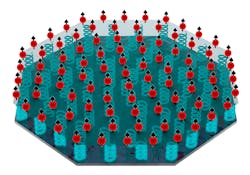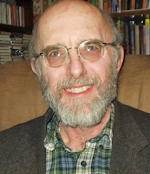“Quantum sensing has been pursued for a longer time than quantum computing, going back to the early days of the squeezing of light to generate a quantum state of light over three decades ago,”1 says John Bollinger of NIST (Boulder, CO). Since then, squeezed light has been used to increase the sensitivity of optical measurements, and to entangle light for quantum-key distribution.2 But according to Bollinger, the first application of quantum sensing that is “making a difference” in fundamental physics is the use of squeezed light to lower the noise floor of the Laser Interferometer Gravitational-wave Observatory (LIGO), starting in 2019.
Albert Einstein’s general theory of relativity predicted gravitational waves a century ago, but they proved hard to detect. Joseph Weber first searched for them in the 1960s at the University of Maryland (College Park, MD), but his instruments fell far short of the sensitivity needed. LIGO began operation in 2002, but required a series of upgrades before it detected the first gravitational waves in 2015. Adding squeezed light to the interferometer in 2019 lowered the noise floor, allowing LIGO to detect gravitational waves from more cosmic collisions millions or billions of light years away.
Squeezing light enhances sensitivity by using a loophole in the uncertainty principle, a quantum mechanical law that limits how precisely we can measure the product of two parameters of electromagnetic or gravitational waves, such as amplitude and phase. Nonlinear devices can “squeeze” light by reducing one component while allowing the other to increase, so their product remains above the minimum. The nonlinear optics in LIGO squeeze the light-measuring gravitational waves, reducing the uncertainty in the phase while increasing the uncertainty in amplitude. Because LIGO’s final detector responds to wave phase but not to amplitude, this lowers the noise floor so LIGO can detect more distant events.
Quest for dark matter
Quantum computing, communications, and cryptography have lately been getting more attention than sensing, but quantum sensing is coming on strong in other demanding applications in basic science. Bollinger’s group has demonstrated a different type of quantum sensing that they hope can detect another elusive physical phenomenon: dark matter. That’s the maddening stuff that we have never been able to observe directly because it does not absorb or emit light, but does reveal its presence by its gravitational effect on the rotation of galaxies.
We don’t know what dark matter is, but theorists have proposed some ideas. An attractive idea is axions, which would behave more like an oscillating field permeating the cosmos than individual particles. In theory, axions interacting with strong magnetic fields could induce motion of charged ions at frequencies resonant with the axion field. Mechanical oscillators can be highly sensitive quantum tools for measuring small displacements such as those that axions would produce. In the August 6, 2021 issue of Science, Bollinger’s group reports demonstrating quantum-enhanced sensing of similarly small displacements from other forces.3 Their sensor demonstrates sensitivity 9 dB below the standard quantum limit, an important advance in chasing axions (see Fig. 1).
Their sensor uses 150 beryllium atoms evenly spaced in a 200 µm planar “crystal,” but it’s far from small and simple. It requires quantum entanglement, cooling to a small fraction of a millikelvin above absolute zero, and a magnetic field of 4.5 Tesla. But if their quantum sensor can find the elusive axions, it could bring them a Nobel Prize.
Starting with a trapped-ion quantum simulator
The NIST sensor grew out of studies of quantum coherence in the nanomechanical oscillation of clusters of cold-trapped ions. In 2012, NIST analyzed the properties of “drumhead” modes in a submillimeter planar crystal of several hundred beryllium ions confined in a Penning trap.4 Drumhead modes are vertical oscillations similar to the motion of a point on a drumhead, but in this case measured for individual ions evenly spaced across a spinning 2D disk. When laser-cooled to near absolute zero, the outermost ion electron in each atom is a spin 1/2 system that can store information as a quantum bit (qubit). Collectively and when laser-cooled to near absolute zero, the whole structure can simulate the behavior of a quantum system. “Quantum simulation hearkens back to analog simulations,” Bollinger says.
Often called analog computers, analog simulators are physical devices that model a process in a controllable way. They faded away as the power of digital computers increased because digital processors can be used for general-purpose computation, making them much more flexible. However, analog simulations continue to be used for special purposes, such as with wind tunnels to model the complex processes of turbulence.
“Quantum simulations have been around for 15 years or so, and it will be a long time before we have a fault-tolerant quantum computer with many qubits,” Bollinger says. Today, the largest assemblages of high-quality qubits in optical computing are 40 qubits without error correction, or 5–10 qubits with error correction. Larger arrays of higher-quality and correctable qubits are in development, but he says in the meantime, lots of quantum-mechanical systems can be understood by using well-controlled simulations such as the NIST ion system. For example, well-controlled quantum simulations can be run to model the time evolution of states governed by Hamiltonian operators. Quantum simulators are important in studying high-temperature superconductivity.
Early quantum simulators suffered from instabilities that could destroy fragile quantum effects, so they required refinements. In 2016, the NIST group developed a new type of Penning trap setup to increase the speed and strength of interactions among beryllium ions. Better lasers improved control of the ions and superposition of quantum states. Entangling photons enabled the generation of squeezed spin states, reducing quantum noise, and making the disks better controlled and more attractive for atomic clocks, as well as for quantum simulators.5
The next step in improving sensitivity performance was to “flash freeze” a 250-µm-wide disk of 150 beryllium ions to 50 µK. Their final stage of cooling focused two lasers emitting at 313 nm, with wavelengths offset from each other at a frequency chosen to drain vibrational energy from the ions’ drumhead modes. The temperature was not the lowest on record, but it did cool the ions close to the quantum mechanical ground state for their drumhead mode, providing the tighter confinement needed for quantum simulations and quantum sensing.6
Entangling mechanical and electronic properties
Now, the NIST group has gone further by entangling the mechanical motion and spin of the outer electron in another array of 150 beryllium ions in a 200 µm disk (see Fig. 2). Using that quantum effect and other refinements, they were able to detect an electric field of 240 nV/m in one second, more than 10X lower than the minimum sensitivity of their earlier sensors; this demonstrated a quantum advantage over conventional sensors in protocols that do not use entanglement. The demonstration is more than 10X lower than that realized in any atomic sensor, putting them into the realm needed to detect axions. The NIST group reported their experiment in the August 5, 2021 issue of Science.7Entangling electron spin and motion is important because it can cancel the intrinsic quantum noise from the ions, says theorist Ana Maria Rey of the Joint Institute for Laboratory Astrophysics (JILA; Boulder, CO), a co-author of the paper. However, it is tricky to measure the entangled state without destroying the information shared between electron spin and motion.
Bollinger’s group found they could preserve the shared information by essentially turning back the clock and reversing the dynamics that entangled the spin and drumhead motion to disentangle them. The key was to entangle the spin and motion by illuminating the sensor with an optical displacement force produced by a pair of crossed laser beams with wavelengths that differed by a microwave frequency very close to the drumhead frequency of the ion motion. That leaves the trapped-ion crystal vibrationally excited, but in a way that depends on the spin-state of the crystal. A microwave pulse then rotates the electron spins, and the entanglement process is time-reversed to disentangle the spin from the drumhead motions. The symmetries of the entanglement process add up to allow fluorescence imaging to measure ion displacement with a sensitivity 9 dB below the standard quantum limit. According to Bollinger, this “is what got this published in Science.”
Next steps
“We aren’t ready to jump into axion hunting,” Bollinger says. That requires precise knowledge of the drumbeat drumhead mode frequency, but in the current single-plane trapped-ion sensors, that frequency lacks the desired stability. Another issue is the presence of thermal phonons in the system. “Those issues are not fundamental in nature and could be resolved in next-generation experiments,” the group wrote in Science. They expect those improvements would lead to trapped-ion sensors sensitive to an electric field on the order of 10 nV/m in one second.
Achieving that sensitivity would allow trapped-ion sensors to detect axions (and another type of dark matter called hidden photons) at frequencies of 10 kHz to 10 MHz, a range limited by the drumbeat drumhead mode frequencies of the ions now used. That’s only a small part of the frequency range thought possible for axions, which along with weakly interacting massive particles (WIMPs), are considered the leading contenders proposed so far for dark matter.
Many instruments have searched for dark matter, including axions, but none have found it. The NIST group says trapped-ion sensors have some important advantages in the quest for axions. Trapped-ion sensors need strong magnetic fields to keep the ions trapped, so they provide those that are also needed to couple axions to electric fields for detection. The drumhead modes in trapped-ion sensors can be readily tuned in frequency, unlike other axion detectors based on superconducting qubits that require low magnetic fields and are difficult to tune.
Bollinger is intrigued by the possibility of scaling up trapped-ion sensors to 100,000 or a million ions by developing 3D crystals. Sensitivity would increase proportionally to the square root of the number of ions, and he expects a 3D crystal would have a more stable drumbeat motional frequency—but that would be further in the future.
Hunting for dark matter is a high-stakes quest in basic science. Similar to LIGO, instruments trying to find dark matter must operate 24/7 for long periods, searching signals that are rare as well as weak. Trapped-ion sensors won’t be as gigantic as LIGO, but neither are they small. Figure 1 shows the optics and some instruments, but the white pillar at left hides the large chamber, which includes the cryostat with superconducting coil 1 m wide and 1.5 m high that generates the magnetic field, similar to those used in nuclear magnetic resonance imaging. “It’s not something you are going to pick up and move around,” Bollinger says.
Nonetheless, in time, such instruments may pave the way for more compact and quantum sensors with a wider range of applications.
REFERENCES
1. R. Slusher et al., Phys. Rev. Lett., 55, 2409 (1985); doi:10.1103/physrevlett.55.2409.
2. T. Gehring et al., Nat. Commun., 6, 8795 (2015); doi:10.1038/ncomms9795.
3. See https://bit.ly/LFW-Sep21-HechtRef3.
4. J. Britton et al., Nature, 484, 489–492 (2012); doi.org/10.1038/nature10981.
5. J. G. Bohnet et al., Science, 352, 1297–1301 (2016); doi.org/10.1126/science.aad9958.
6. E. Jordan et al., Phys. Rev. Lett., 122 (2019); doi:10.1103/physrevlett.122.053603.
7. K. A. Gilmore et al., Science (2021); doi:10.1126/science.abi5226.


